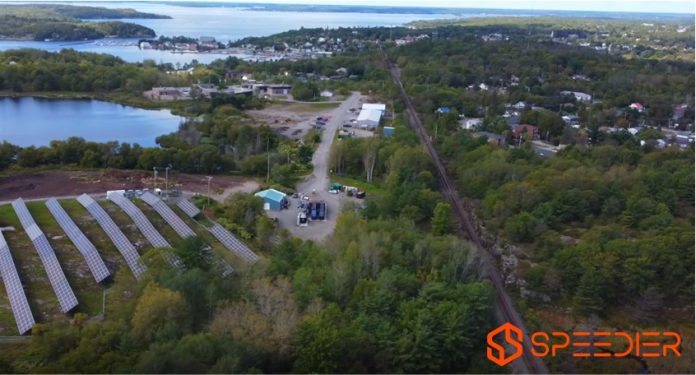Project SPEEDIER has completed the construction of a microgrid in Parry Sound, to assist the Town with meeting its goal to become a net-zero community. This three-year local project was led by Lakeland Generation with support from the Town of Parry Sound and Georgian College and a $3.75-million investment from the Government of Canada. Project SPEEDIER is in alignment with Natural Resources Canada’s (NRCan) objectives of reducing GHG emissions, to adhere to Canada’s Paris Agreement commitments, and to maintain the natural beauty of the Parry Sound area.
The SPEEDIER team is pleased to announce that the completion of a 3rd party audit as a requirement of the NRCan funding has validated the accuracy of the GHG reporting methodology developed by the project team.
The SPEEDIER project reduces GHG emissions by generating clean solar energy and shifting part of Parry Sound’s electricity load to times when the provincial electricity generation mix is cleaner, using energy storage technologies. The project saw the installation of a 500kW AC/648kW DC Solar Net Metering Solution and a 2.514 MWh Tesla Battery Energy Storage System (BESS), as well as a Level III DC Electric Vehicle Fast Charger, three Level II Electric Vehicle chargers and 10 Tesla home Powerwalls. Lakeland Generation already produces clean, renewable energy in Parry Sound through their 3.25-megawatt Cascade waterpower generation plant.
Lakeland Generation worked with Georgian College’s Research and Innovation department to develop a GHG Information System (GHGIS) to track emission reductions. Scott McCrindle, a professor in Georgian’s Computer Studies academic area, has a Master’s degree in Environmental Practice from Royal Roads University with a focus on Distributed Energy Technologies (DET). McCrindle led the research, determining existing emission scenarios that would be negated by deploying each of the assets onto the Parry Sound electricity grid, with consideration to product specifications, deferred or displaced electricity generation, industry best practices and vendor data. The reporting system is based on the internationally recognized GHG Protocol for Project Accounting and the supplemental Guidelines for Quantifying GHG Reductions from Grid-Connected Electricity Projects. These frameworks were implemented to develop the methodology for the baseline emission calculations and the potential GHG reduction projections.
At project end, an audit team engaged by NRCan conducted an in-depth review of the GHGIS work done by the SPEEDIER team and validated that the formulas are reasonable and comply with industry-standard guidelines.
With this validation, GHG reporting starting in July 2021 is finalized and posted online. New reports will continue to be published regularly on the www.speedier.ca website. The reporting includes actual GHG savings and visual infographics to help readers understand what the reductions mean.
“Lakeland has been very fortunate to have the expertise and guidance of Scott and the team at Georgian College,” said Chris Litschko, CEO. “Scott’s report is industry-leading on the process of completing the NRCan GHG reporting template, which will provide the analysis of our Parry Sound project outcomes for years to come and will be the basis of future internal and external project emission measurements.”.
McCrindle is grateful to work with Lakeland on this ground-breaking initiative. “This collaborative effort to implement frameworks that account for the GHG performance of the SPEEDIER project will help electrical utilities to more effectively integrate and deploy smart grid technologies. Such assets can improve grid resilience, responsiveness, and flexibility, while also producing verifiable reductions in GHG emissions. This important research is an example of the type of work required to develop more sustainable energy systems — work that will require the courage and imagination of people who are willing to do things differently.”








